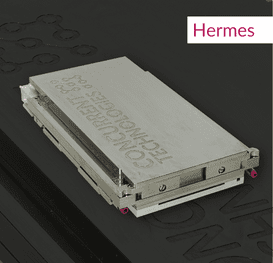Concurrent Technologies plc (LON:CNC) Strategy Director Nigel Forrester caught up with DirectorsTalk to discuss what the company does, the launch of their new product ‘Hermes’, and their progress in systems.
Q1: Just as a quick recap, could you explain what Concurrent Technologies do?
A1: So, we’ve been around for nearly 40 years and during all of that time, our main focus has been on providing Intel processor-based cards for a wide range of embedded applications including those in the defence, telecommunications, medical, in basically anywhere where there’s a critical embedded market.
We’re a UK designer and not just a designer, we actually manufacture these cards ourselves in one of our factories in the UK, which is absolutely fantastic. It’s quite an unusual thing to do to manufacture Intel processor boards in the UK.
Whilst we’ve been very very successful and we’re a profitable company, about 18 months ago, we decided to broaden our strategy to include more than just boards. So, typically these boards are based on open systems and they’re plug-in cards but we had effectively sold those to a range of companies who did, if you like, the installation of those cards into systems or boxes.
So, we’re now starting to do that ourselves and in order to enable us to do that, we broadened, also widened our ecosystem. So, had a couple of announcements recently about a couple of critical partners that we’re engaged with to also use their cards along with our own Intel processor boards to provide a much more suitable solution.
Just to give you a quick idea of the sort of things that our computers are involved in range from very wide range of the defence side, things like situational awareness, understanding what’s going on in the environment, providing actionable intelligence from a range of sensors.
In the medical side, we have products in all sorts of infrastructure equipment doing some clever things from a medical perspective.
In the telecoms side, we are the basis of a lot of the test equipment so the mobile networks are functioning correctly.
So, it’s a really really interesting place to be in and, as I said, we’ve broadened our scope a little bit recently.
Q2: Now, you’ve launched a new product called Hermes, why would this be interesting for investors?
A2: First of all, there’s a number of key issues that we’re trying to address with Hermes, so the first and probably the most important point is that Hermes reinforces our leadership in a particular area of the market, focussed around the defence space predominantly.
There we introduced, about 18 months ago, two new plug-ion cards that have managed to engage us in a number of critical opportunities so those cards have got some really exotic new capabilities for us. To give you a good example, on the ethernet side, we’re now providing cards which are capable of 100 gigabit ethernet connectivity. These things are quite small, they’re about the size of a postcard and just to give you a date and point, the laptop that I’m connected with today has a 1 gigabit ethernet connection, that’s quite normal in an office environment. The cards that we’re providing have 100 gigabit connectively so that’s a 100 times the bandwidth but the bandwidth is not all important there.
There’s also some issues around latency so that’s the quickness that the various messages can get to the receiver so it’s really really important that if we’re going to live the dream of being a leader in this space, that we actually keep up with that cadence.
In order to do that, we’re really working in lockstep with our key technology provider, which is Intel. So, we are one of the lead customers and we’re a titanium partner with Intel and we’re really keen to be working with them and really pleased that we’re a partner on the launch campaign of this particular chipset.
So, to give you an idea, Intel launched a version of the chipset that we were using last week and we’ve now launched our first product based on that chipset. That’s really important that we continue to keep up that cadence which demonstrates to our customers that no matter what their application is, we can keep providing them with a state of the art product.
The last point really about Hermes, the product that we announced last week, is that whilst it’s a great standalone plug-in card, and lots of our traditional customers will be, I’m sure, using that in the future. It’s also going to form another pillar that we can use to attack the systems market going forward, where we can use that as the basis of many other projects that we’re able to do with our customers.
Q3: You’ve mentioned systems there, can you give us an update on Concurrent Technologies’ progress in systems?
A3: We’ve done quite a lot of things in the last 18 months.
One of the first things we did was we introduced a new product called Vulcan which is designed so that our customers can start developing straight away with these latest technology products that I was talking about, the 100 gigabit ethernet. You have to have a system that’s capable of manging that bandwidth. So, Vulcan is a very easy, flexible system that the customers can adapt to their own types of applications to make the connectivity between the different types of cards easily.
Secondly, we’ve introduced a number of products now that are more application focused, I’ll give you a good example, we have a product called Hermod, it’s fully shipping now, and it is a rugged ethernet switch. So, that ethernet switch, if we’re talking about a ‘system of systems’ type of approach, you have to have a way of connecting the different boxes, maybe you’ll have a navigation box, maybe you’ll have a timing product or a mission computer or a vision computer, they all need to be interconnected. This is so you can share the actionable intelligence between them and so Hermod acts as that type of gateway between the boxes.
The second example we’ve got about progress on systems is a product we announced a couple of months ago, and that’s our first vision computer systems called Helios, that is very much aligned to the concept of doing things like 360 degree situational awareness. It’s progressing well, we’ve actually got prototypes available already and we’ll be shipping that as a fully qualified product in Q3, on plan. So, those are the sort of things which in their own right adds a different dimension.
We’re trying to build again on the fundamental building blocks that we’ve got, adding a little bit of differentiating functionality in there and now starting to make something that will deliver something that is quite specific to a particular type of application.
Over this year, you’ll see some more announcements as we are able to deliver some additional capability that is focussed towards specific areas of interest.








































